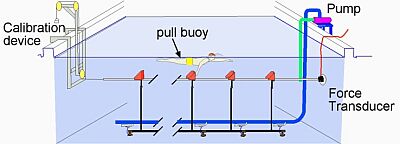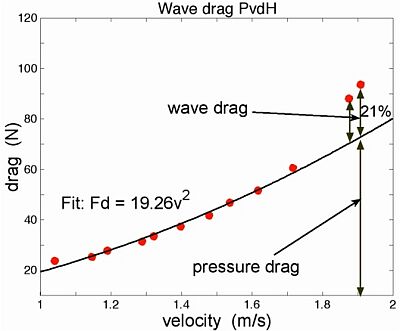
Measurement of active drag in swimming
H.M. Toussaint
Kinesiology, Inst Fundamental & Clinical Hum Mvmnt S, Amsterdam, The Netherlands
A considerable part of the energy expended in swimming is used to overcome drag [1]. Drag is therefore one of the factors that may limit swimming performance. Throughout the history of swimming research, attempts have been made to measure this resistance.
During swimming, it is obvious that the body changes form, since it needs to generate propulsion. It has been conjectured that the movements necessary to create propulsion could induce additional resistance. This so-called 'active drag' is difficult to determine directly, because the forces that act on the swimmer must be measured without disrupting the natural swimming movement. Unlike activities on land, propulsion is not generating by pushing off from a fixed point, but by giving an impulse to the water, which then gives way [2]. So, where should we attach the force transducer?
The MAD-system provides a solution to this problem by allowing the swimmer to push off from fixed pads with each stroke (Figure 1). These push-off pads are attached to a 22-m long rod. The distance between the push-off pads can be adjusted (it is normally 1.35 m). The rod is mounted ± 0.8 m below the water surface and connected to a force transducer, enabling direct measurement of push-off forces for each stroke. Subjects use their arms only for propulsion; their legs are floated with a small buoy. If a constant swimming velocity is maintained, the mean propelling force equals the mean total drag force. Hence, swimming one length on this system yields one data point for the velocity-drag curve.

Figure 1. MAD-system mounted in 25-m pool.
The force signal recorded between pushing off from the second pad and reaching the last (16th) pad is time-integrated, and yields the average force applied during a swim of 14 x 1.35 = 18.9 m. The mean velocity is computed from the time taken to cover the distance between the second and last pads. Subjects swim ten lengths on the MAD-system, each at a different but constant velocity (range = 1-2 ms-1). For each length, mean drag force and mean swimming velocity are measured. These ten sets of velocity/drag data are then least square fitted to the function:
Fd = A * vn
Where Fd represents total active drag, v equals swimming velocity, and A and n are parameters of the power function. Figure 2 gives an example of the drag dependent on speed for one subject, where drag was measured on three separate days. It shows the remarkable reliability of the drag measurements.

Figure 2. Drag dependent on velocity.
Among other things, this system can be used to estimate the magnitude of wave drag as a component of total drag (Figure 3).

Figure 3. Estimate of wave drag.
References
Paper presented at Measuring Behavior 2002, 4th International Conference on Methods and Techniques in Behavioral Research, 27-30 August 2002, Amsterdam, The Netherlands